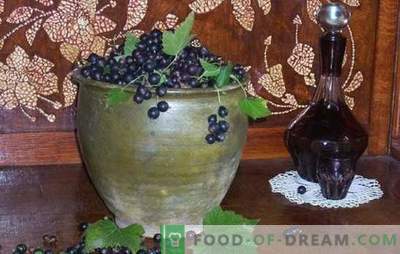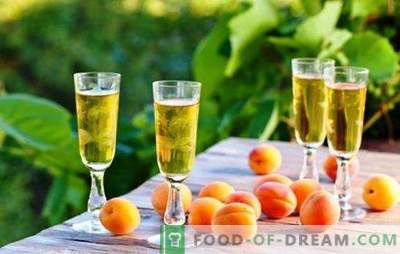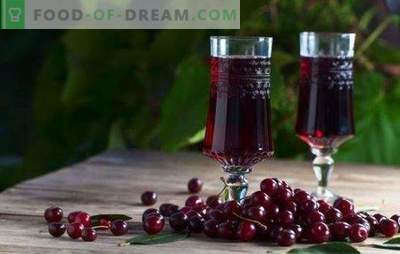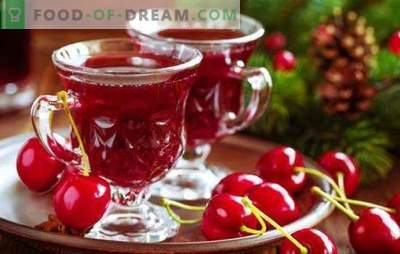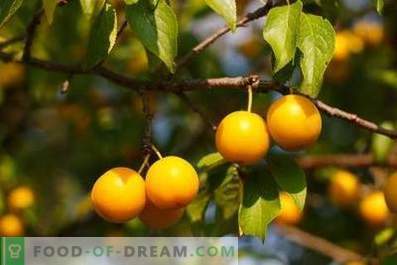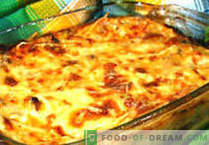
Everyone is familiar with the basics of home-made winemaking, especially the summer residents, on whose plots fruit trees and berries grow every year. Not all harvest is used in the form of jam and compotes.
Homemade wine can be the subject of extraordinary pride of the one who created it. Yes, wine is prepared, made, and good wine is created as a work of art. Even a cherry familiar to everyone can be an excellent source of inspiration here.
Cherry wine at home - basic technological principles
All stages of the preparation of fruit and berry wines are similar to the production of grape wine, which has been considered a classic of winemaking in the world for thousands of years. The difference between these two types of wine material is only in the biochemical properties of the fruit. In particular, to obtain high-quality wine juice from cherries must have an adequate and necessary amount of sugar, acid. These norms were revealed experimentally in the process of winemaking development. It is established that when the acid content is 0.7% in prepared wort, it turns out good quality wine, not sour and not prone to diseases that develop in the finished product with an excess or lack of acid.
Therefore, the fruit and berry raw materials after collecting, sorting and obtaining juice is adjusted to the required characteristics. To normalize the acidity of cherry juice, it is mixed with water or other fruit juice, since the acid content in the berries of some varieties of cherries exceeds the required value by 3 times. For this reason, it is impossible to obtain a natural wine, based on pure juice, from many fruits.
The sugar content of wine materials is a matter of not only the proper fermentation of the wort, but also the production of the required type of wine, with the required alcohol content. In this sense, fruit and berry raw materials also have a wide range of sugar content.
The low sugar content in the wort does not give the necessary energy to the yeast, turning the wine into vinegar, and its excess slows down the work of the yeast. Therefore, sugar is added to the natural sugar, which is contained in cherry berries, taking into account the requirements for the future strength of the wine. On average, to obtain a dry wine (9-12 vol.), The sugar content in the fruit mash should reach 22-24% per liter. It should be borne in mind that a dry wine made from cherries at home is a recipe that is not the most successful: this wine will be unstable, sour to taste. More successful options are dessert and strong wines, with the addition of alcohol (vermouth, tokay or sherry) based on cherry juice or using this wine material (remember that any standards and classifications are permissible in home winemaking).
To the natural sugar content of cherries you need to add sugar enough to get the necessary strength of the wine. Sometimes it is added to the wort immediately in the right quantity, but in the manufacture of some wines, its gradual introduction is provided in parts. First, the sugar is added during the fermentation process, and then, if necessary, in the finished wine, thereby increasing its strength and achieving the required taste. In addition, sugar is added to young wines to completely stop fermentation (for sweet and dessert wines). Also, sugar can be added to the young wine, where the fermentation process is not completely stopped, directly in the bottle, to produce sparkling wine from cherries at home.
The recipe for this wine, as well as other recipes, read below.
Cherry wine at home: a recipe for an old Russian drink in a modern interpretation
Of course, not every summer resident can find a real oak barrel with iron hoops, but if there is one, then the old cherry wine will be obtained not in the interpreted, but in the most original version. Just need to fill this keg with cherries and honey, tar and bury for 3 months in wet sand.
For those who do not have such a “treasure” as an oak barrel the method of preparation is attached below. Perhaps it differs from the previous one, but only by the realization that this method is not ancient, although the wine in both cases turns out to be unusually tasty and beautiful.
Composition:
- Cherry with a stone 2 parts
- Honey, fresh (May) 1 part
- Oak bark (for glass containers) 5% by weight of raw materials
Cooking Technology:
Fresh, just harvested and ripe cherries are picked and put in a keg or glass bottle in layers, each of which must be watered with honey. In the glass bottle between the layers of cherries add oak bark. The barrel can be filled to the top, and in a glass container 1/3 of the container should remain empty. Wear a rubber glove on the wide-necked bottle without piercing it. Cover the barrel with a lid, carefully grinding it and putting hoops on the wooden container. To prevent the keg or bottle from breaking during the fermentation process, bury them in wet sand. The bottle can be put in a pre-prepared sandbox. To ensure that there is enough pressure on the outside of the tank, watch for the constant high humidity of the sand. After 3 months, dig up the container, print it out and pour the wine through the filter into a clean dish. Wrap the thick in linen canvas and put it under the press. Squeezed wine combine with the bulk. Bottle the wine. Seal and store in the basement. This wine can be stored for 5-6 years.
Cherry wine at home: recipe of fortified wine
Composition:
- Raisins, red 200 g
- Water 2.5 L
- Cherry 10 kg
- Oak leaves, green 300 g
- Sugar 3.3 kg
- Dried prunes 500 g
- Alcohol (96%) 750 ml
Cooking Technology:
A week before the start of the vintage make raisin sourdough. In a jar with a capacity of 1.5-2 liters, place the raisins with sugar and fill with warm water. To do this, from the total amount of water, take 0.5 liters and heat to 25 degrees. The bank must be filled to 2/3 volume. Bind the neck with a gauze or linen napkin, and place the jar closer to the heat, but not next to the included plate. Shake the starter periodically to avoid acidification of the surface.
Berries cherry technical ripeness sort out, removing the bones. Fold in the enameled container (15 liters), pour in 2 liters of water (20 degrees) and add 1/3 of the sugar. Stir and put the container in the heat for 2-3 days, before fermentation.
Fermented cherries put under the press to separate the juice. Pour the juice into the bottle in which you will “play” the wine, after adding the leaven to it (without the raisins). Put pressed leaves with prunes and chopped oak leaves into another bottle and fill with alcohol. Seal the alcohol extract tightly and leave to infuse until the wine is clarified. Put the bottle of juice in a room with a constant temperature, without access of bright sunlight and drafts. The neck is sealed with a medical glove. As soon as the rapid fermentation begins to subside, add the second part of the sugar to the bottle and put the glove back on the neck. Wait for the complete cessation of fermentation. After two weeks, the wine should become transparent, and sediment will be visible at the bottom of the bottle. Insert a plastic or rubber tube into the bottle and pour the wine into a clean container, taking care not to hook the residue on the bottom. The precipitate can be drained into a jar and used as a starter for the preparation of other wines. Wash bottle, sterilize and re-pour wine into it. At the same time, strain the alcohol tincture and also put it to clarify. After removing from the sediment, again, the wine and tincture. Combine them by adding the remaining sugar. Stir the sugar until dissolved. Put the wine in a cool dark place for at least 6 months. The bottle should be carefully clogged to avoid moisture and foreign odors from outside.
Cherry liqueur wine at home. Recipe blended wine
Blended wines in a production environment are often prepared by mixing selected ready-made wines. But at your summer cottage from this rule, you can retreat and combine the wine in one bottle. It is important to decide right away: if the wine is cherry, then it is these berries that must be present in the prepared wort in an overwhelming amount in order for the name to match the composition of the wine.
Composition:
- Raspberry (juice) 3 l
- Apricots (puree) 5 kg
- Cherry (pitted) 8 kg
- Sugar 3.6 kg
- Tannin 25 g
- Orange zest 100 g
- Citric acid 55 g
Cooking Technology:
For this recipe, neither wine sourdough nor yeast are required, as raspberries are present in the wort. Separate cherries from pits. Combine the berries with raspberry juice and apricot puree. Add orange zest, citric acid and half the sugar. Put the prepared wine material before fermentation in the heat, having covered the bottle. 2-3 times a day, mix the prepared mash with a wooden spatula. Place the fermented material under the press. The resulting juice is poured into the bottle and install a water seal on it.
After fermentation, to speed up the process of clarification and improve the quality of wine, pour a small amount of young wine into a quart jar and dissolve tannin in it. Pour the wine back into the total mass and mix. Clear clear wine from sediment and add to it the second half of sugar. To do this, pour a small part of the wine into enameled ware again, add sugar and stir it, warming, until dissolved. Mix both sides of the wine and bottle. Seal the bottles and put in a large saucepan. Fill it with water so that the bottled wine and water are on the same level. Warm up the pan for 10-12 hours, maintaining a water temperature of 70 degrees in it. After the water has cooled naturally, remove the bottles and transfer them to the basement.
Muscatel cherry wine at home. Recipe for experiment lovers
Composition:
- Cherry, dried 1 kg
- Raisins, white (from muscat grapes) 0.5 kg
- Sugar 600 g
- Yeast 1 g
- Oak bark 50 g
- Ground nutmeg 2 g
- Grape juice (canned) 6 l
Cooking Technology:
This wine can be made at any time of the year, if these ingredients are present. It is enough to harvest the cherries and grapes during the season, drying their berries in the oven. Instead of water, for a more saturated taste of wine, use canned grape juice.
Crush raisins. Cherry can be used together with the bone: because of its small amount, the poisonous elements that are often mentioned in the bones are not harmful to health, and besides, the wine will acquire a light almond flavor. Heat grape juice to 20-25 degrees and dissolve 1/3 of sugar and yeast in it. Put the prepared berries in a bottle with a wide neck and pour them with sweetened juice. Put a glove on the neck of the bottle and place the wine for fermentation in a room with a constant temperature of 18-22 degrees. Add the remaining two parts of the sugar to the fermented wort while slowing down the fermentation, after 10-14 days. At the end of the fermentation process, place the oak bark and ground nutmeg in the wine bottle. After waiting for clarification, remove the wine from the sediment. If the wine in two weeks still does not become transparent, still remove it from the sediment and, overflowing into a clean bottle, continue to lighten it. Repeat the removal, achieving transparency. Pour the finished wine in bottles of dark glass, seal. To withstand at 10-12 degrees need at least a year.
Sparkling cherry wine at home. Recipe for cherry semi-sweet “champagne”
Of course, real champagne is a special sparkling wine made only in the Champagne region. But, if you wish, you can shoe a flea. Carbon dioxide is a gas that produces young wine, and if it is slightly fermented in a sealed bottle, you can get the effect of sparkling wine from any fruit. There is another nuance. In the province of Champagne, in order to impart a special taste, sparkling wine is flavored with a special liqueur, the recipe of which is kept secret. Well, let it be stored! You can try to open a new taste, and it may happen that it will be even better than the famous French champagne.
Composition:
- Purified Water 7 L
- Sugar 3.3 kg
- Raisin, red 2.8 kg
- Alcohol (93.6%) 200 ml
- Cherry 1.0 kg
- Fermented Grape Juice 350 ml
Manufacturing Technology:
200 g of crushed raisins and put as much sugar in a jar (2 l). Fill the mixture with warm water at 3/4 volume jars. After 4-5 days pour the finished starter into the wort.
For the mash, also chop the rest of the raisins, combine with sugar (1.5 kg) and, putting in the bottle, fill with warm water. Pour the leaven, mix. Cover the bottle neck with a cotton swab and place it in a room with a constant temperature of 20-25 degrees. Immediately after the start of fermentation, install a water seal. After about 60 days, if everything was done correctly, the fermentation will stop. Wine must be removed from the sediment and filtered.
Sort out the cherry, wash and remove the bones. Crush the berries and add 1 kg of sugar. Put the berries with sugar in the bottle, pour with alcohol and cover tightly with a lid. Shake the bottle periodically, and soak the cherry tincture together with the raisin wine for 2 months. Pass it through the filter.
Connect the young wine with tincture. Soak for 10-14 days. If necessary, remove the wine from the sediment once more and pour it into prepared champagne bottles, without pouring 8 cm to the edge of the neck. Add 50 g sugar to each bottle and pour the same amount of fermented juice into each bottle. Temporarily, for 10-12 hours, seal the bottle with a gauze pad and leave at room temperature. As soon as bubbles appear, remove the tampons and seal the wine with plastic stoppers, tying them with string or wire. Transfer the bottles to a room with a temperature of 10-14 degrees and lay on a shelf in a horizontal position. Sparkling wine will ripen in 3 months, but the older it gets, the tastier it will be. Although it is unlikely to lie in the home wine cellar for more than a year.
Wormwood wine from cherry at home. Cherry Vermouth Recipe
Composition:
- For a spicy herbal tincture, 20 g each:
- Ground orange peels,
- Alpine wormwood,
- Peppermint,
- Cardamom,
- Nutmeg,
- Cinnamon,
- Yarrow;
- Oak bark 50 g
- Alcohol (93%) 0.7 l
- For wine:
- Sugar 3.0 kg
- Cherry, fresh 4.5 kg
- Water 2 l
Cooking Technology:
Cherry pulp (crushed pitted cherries), fill with warm water (25 degrees) and add 2 kg of sugar. After fermenting the wort, pour it into the bottle, set the water seal and place the cherry wine for fermentation. At the same time, chopped herbs should be poured with alcohol, sealed the container and allowed to stand until the wine passes the clarification stage. Filter tincture until complete removal of microparticles of herbal mixture.
Remove the wine from the sediment with the finished tincture, the rest of the sugar and put it in the cellar for six months.
Repeat the removal from the sediment, if it appears during aging, and pour the wine into cooked dishes.
Cherry wine at home - tips and tricks
- In the process of aging wine must be checked. When sediment reappears, it must be removed by pouring wine into a clean container so that the drink does not acquire unpleasant bitterness.
- Cherry wine, provided it is properly made and its storage conditions are met, can be not only usable, but even more tasty even after 5-6 years.
- If you notice a precipitate or turbidity in alcoholic beverages, it is better to stop using them. Contrary to popular belief that alcohol is a disinfectant, they can be poisoned. Do not forget that in alcoholic beverages, and even strong medicinal tinctures, there are certain periods of storage. Alcohol poisoning can lead to fatal consequences.



